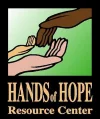A QUARTERLY PUBLICATION OF HANDS OF HOPE RESOURCE CENTER.

This has been a challenging year. At the time of this writing, there have been 24 confirmed victims of intimate partner homicide in Minnesota in 2023, with roughly 15% of them being within 50 miles of our Little Falls office.
October is Domestic Violence Awareness Month. If the information above does not outrage you, there are an additional 275 million children worldwide that are exposed to family violence in the home each year (according to Futures Without Violence).
What can you do? First, don’t turn a blind eye. You may be the only lifeline someone has to escape from a domestic violence situation. Second, know the resources in your area to help someone leave, such as an advocacy program or shelter. Third, do what you need to do to keep yourself safe. Domestic violence can be a very dangerous situation for law enforcement and others who attempt to intervene.
It seems like a small gesture, but simply wearing the color purple or a purple ribbon signals to a victim of domestic violence that you are aware, that you care, and that they can talk to you about domestic violence.
If you are interested in more resources to help others, please give me a call. I would welcome the opportunity to speak to you or your group about the dynamics of domestic violence and what you can do to help end it.
~ Stephenie Och
Domestic Violence Awareness Month
by Barb Goodrich
Domestic violence, also known as intimate partner violence, is a serious and widespread problem. In the United States, 1 in 4 women and 1 in 9 men experience contact sexual violence, physical violence, and/or stalking by an intimate partner in their lifetime and report negative impacts such as injury, fear, concern for safety, and needing services. Domestic violence can happen to anyone regardless of employment or educational level, race or ethnicity, religion, marital status, physical ability, age, sex, gender identity, or sexual orientation.
October is Domestic Violence Awareness Month (DVAM) and was founded by the National Coalition Against Domestic Violence (NCADV) in October 1981. Originally called the “Day of Unity,” the occasion went on to be a week of local, state, and national events before eventually becoming a month-long campaign. The first DVAM was held in October 1987, the same year the first national toll-free domestic violence hotline was launched. Two years later, the US Congress legally designated October as Domestic Violence Awareness Month – a chance for people to learn more about the effects of domestic violence, spread awareness, and take action.
Domestic violence awareness has often been represented by a purple ribbon, which symbolizes the bravery and strength of survivors of domestic violence and those who have lost their lives to abuse. If you are passionate about ending domestic violence and spreading awareness, consider wearing a purple ribbon during the month of October and sharing with people you know and meet about the reasons behind the color choice.

Effects of Domestic Violence on Children
by Rocio Fernandez Lugo

According to the National Coalition Against Domestic Violence’s statistics, 1 in 15 children are exposed to intimate partner violence each year, and 90% of these children are eyewitnesses to this violence.
Many children exposed to violence in the home are also victims of abuse. What is important to remember is that, even though you may think they haven’t witnessed, there is a good chance they have. Children who live in an abusive home are often referred to as the silent victims. Children who witness domestic violence or are victims of abuse themselves are at serious risk for long-term physical and mental health issues, this is why early intervention is so important.
SHORT-TERM EFFECTS OF DOMESTIC VIOLENCE ON CHILDREN:
- Generalized anxiety
- Sleeplessness
- Nightmares
- Difficulty concentrating
- High activity levels
- Increased aggression
- Increased anxiety about being separated from a parent
- Intense worry about their safety or the safety of a parent
LONG-TERM EFFECTS OF DOMESTIC VIOLENCE ON CHILDREN
- Physical health problems
- Behavior problems in adolescence (e.g., juvenile delinquency, alcohol use, substance abuse)
- Emotional difficulties in adulthood (e.g., depression, anxiety disorders, PTSD)
WAYS TO HELP
The ways to help children who are victims of domestic violence include:
- Arranging school-age children to receive counseling from professionals at their school.
- Experimenting with various types of counseling: play therapy, peer support groups, anger management classes, and safety programs to teach kids how to protect themselves in dangerous situations.
- Finding a loving and supportive adult to introduce to the child and encourage the child to spend as much time regularly with the adult. This may include a trusted family member or community advocate. The Family Violence Defense Fund reports that the single most important ingredient to help children heal and develop resiliency is the presence of a loving adult.
- Providing a safe environment that does not include violence in any form after a child has witnessed domestic violence.
- Finding ways to discipline that do not involve hitting, name-calling, yelling, or any form of verbally aggressive behavior.
- Helping children create a sense of safety by having scheduled routines, such as regular meals and homework times.
Despite the high occurrence of childhood exposure to domestic violence, it is important to note that children are inherently resilient and can move forward from stressful events in their lives. Children heal by having adults who care about them provide guidance, attention, and support in the aftermath of domestic violence. While the number of children exposed to domestic violence remains staggering, services are available to those in need. If you or a loved one needs to speak with someone today, please call the National Domestic Violence Hotline at 800-799-7233 or for more information on child abuse and prevention visit the Minnesota Department of Human Services at https://mn.gov/dhs/report-abuse/.
To Whom It May Concern
Submitted for a survivor of domestic violence
by Connie Nelson
To Whom It May Concern,
I’ve been beaten black and blue,
like it’s not enough, raped and strangled too.
To Whom It May Concern,
I’ve been persecuted right and left,
as an abused woman, well, that is what you get.
To Whom It May Concern,
my children need their mama, meaning me,
they have suffered too, so why do you choose not to see?
To Whom It May Concern,
I am bitter and angry with every right,
so why question me, when it’s for freedom I fight?
To Whom It May Concern,
he’s a master manipulator, on a mission to lead you astray,
with sweet fake smiles, he’ll voice his concern, only to get his way.
To Whom It May Concern,
he will strike again, next time it may be too late,
so don’t tell me you didn’t know, that it must’ve been my fate.
Because the truth is, you could have helped.
To Whom It May Concern…
How Domestic Violence Impacts the Workplace
by Cassandra Ortiz


Domestic violence is often perceived as a private matter and therefore is a personal issue that others should not get involved in. However, domestic violence also affects the workplace. It can affect the victim’s overall performance at work such as absenteeism, lack of motivation, and isolation. According to a Canadian analysis, it demonstrated that employers in that country lose $77.9 million because of domestic violence every year (Phillips and Ravishankar). Domestic violence impacts the workplace financially, productivity wise, and can cause a threat to the safety of the employees.
If an employee’s performance is not up to standard, employers should be mindful and ask their employee about their wellbeing instead of critiquing their performance. This can open the conversation for a victim to disclose their abuse and seek help.
These are a few indications of domestic violence that both employers and employees can look out for:
- Bruises or injuries
- Last minute call off
- Lack of motivation
- Lack of participation
- Isolation
- Distant
- Anxious
A victim’s workplace may be their only safe space away from their abuser. The abuser may try to sabotage the victim’s workplace because it also provides financial freedom from their abuser. The abuser may feel jealous because the victim can interact with others besides them. All these factors may lead to the abuser coming to the workplace. In the event that the abuser does enter the workplace, employers should have a procedure in place to ensure the safety of the victim and their employees.
Here are a few actions that employers can take to help a victim of domestic violence:
- Empower employees to support each other. Employers should promote solidity and unity amongst coworkers so that victims may be comfortable enough to disclose abuse to their fellow coworkers.
- Provide training and resources on domestic violence. This can include training on what to do if the abuser were to show up at the victim’s workplace.
- Encourage employees to speak up. Employers should talk with their staff and encourage their employees to report abuse if they feel that there is reason to believe abuse is taking place.
- Allow for flexible scheduling for victims. Victims may need time off work for court proceedings or medical appointments. Employers should consider these factors when creating the victim’s work schedule.
- Revise health care coverage. Employers should revise their current health care coverage to include mental health.
Trick-or-Treat Safety
by Lyndsey Dimateo
It’s spooky season! That means Halloween is right around the corner. We want to ensure your little ghouls and goblins stay safe. Check out the following safety tips to make your trick-or-treating extra sweet!
1. Plan in advance – it is important to plan your route ahead of time so that you are familiar with the area you will be in and the distance you’ll be covering. Inform someone you trust of the route you will be taking so someone is aware of your whereabouts. Always communicate expectations and rules to your children prior to leaving the house. Keep a fully charged cell phone on you.
2. Stay in well-lit areas – being able to see your surroundings is crucial. Try to stay on sidewalks and designated crosswalks. It is always a good idea to bring a flashlight. Only go to homes with the porch light on.
3. Never trick-or-treat alone – going in groups is safer and makes it more fun! If you don’t have a group, go to well populated areas/events. Make sure children are supervised at all times.
4. Avoid using face masks and try face paint instead – masks can make it difficult to see where you’re going and identify a child in case they are to get lost.
5. Check your child’s candy – look for any open or unwrapped pieces. If it appears to be tampered with or is not sealed properly, throw it away. Check the brands of candy and use caution if allowing your child to eat any homemade treats.
6. Make sure the trick-or-treaters at your home are safe too – keep pets inside and remove anything from the lawn that could cause an injury to others.
7. If driving, be mindful of the traffic and the pedestrians around you! Please do not drive distracted.
Morrison County trick-or-treat events:
- BooFest at Pine Grove Zoo in Little Falls, October 21, 2:00pm – 5:00pm
- Business Trick-or-Treat in Little Falls, October 31, 3:30pm – 5:00pm
Todd County trick-or-treat events:
- Trunk-or-Treat at the Long Drive-in Theater in Long Prairie, September 29, 30, & October 7
- Business Trick-or-Treat in Long Prairie, October 31, 3:00pm – 5:00pm
- Trunk-or-Treat at First Baptist Church, October 31, 5:00pm – 7:00pm

Holidays
by Taylor Hernandez

The holiday season is fast approaching. Personally, I have no idea how we got here so quickly. The seasons are changing and to me that is a time of reflection on how the year went: highs and lows and goals for the future.
The holidays mean different things to everyone. When we are spending time with our loved ones participating in our traditions, I ask that you think of those in your own community that won’t have that this year, and if you would like to help, make that dream happen. Please reach out by phone to our Long Prairie office or our Little Falls office in the month of November to be linked up with a family or find out how best to support families in need. This is the part of the holiday season that we look forward to. It is so rewarding to see others faces light up with emotion when they see the outpouring of support from everyone.
I am especially thankful for all the organizations and individuals that thought of us last year during this time by adopting a family for Christmas or just by calling and figuring out what we needed to keep serving these wonderful communities that we do.
Thank you and have an amazing holiday season.
Please Donate Today!
By: Marilyn Bartell, Finance Coordinator
I don’t think people realize how much their donation makes a difference in helping us help victims of crime in our community.
Without your generous donations we would not be able to help the nearly 1,000 victims so far this fiscal year find their way through the court system or connect them with the resources to rebuild their lives.
We need to close our budget deficit and we can only do that with your generous support! This newsletter is filled with many of the reasons why it’s so important that you donate today.
By helping us help victims right here in your own county hold their perpetrators accountable, you are helping our community to be a safer and nicer place to live and raise your family.
Donations can be cash, check, money order or debit/credit card. (You can even remember us in your estate planning.)
- You are always welcome to donate in person at our business office. We love to personally thank our donors.
- By mail to our business office: Hands of Hope Resource Center, PO Box 67, Little Falls, MN 56345.
- Debit/credit cards: go to our website www.handsofhope.net and click on DONATE or simply use your smart phone camera to read the QR code right here and it will take you to our secure donations page.
- You can go to netgiverapp.com. Create an account and search for Hands of Hope Resource Center. Donations here have zero fees and 100% of your contribution goes to us.
When making your donation on-line, please consider becoming a “Friend of Hands of Hope Resource Center” by becoming a monthly donor. Recurring donations can be set up both through our website and Netgiver.
Thank you in advance for your kind-hearted, charitable contributions.
For a volunteer application or more information, please contact Lyndsey, the Volunteer Coordinator, at 320-632-1657 or [email protected].

Where to contact and locate us:
Morrison County
Little Falls Office:
Monday-Friday
8:30am to 4:30pm
Historic Courthouse
107 2nd Street SE, Suite 102
Little Falls, MN, 56345
By phone:
24 hour Hotline:
320-632-4878
Office:
320-632-1657
Fax:
320-632-5457
By mail:
PO Box 67
Little Falls, MN 56345
Todd County
Long Prairie Office:
Monday-Friday
8:30am to 4:30pm
Main Street Government Center
347 Central Ave
Long Prairie, MN 56347
By phone:
24 hour Hotline:
800-682-4547
Office:
320-732-2319
Fax:
320-732-2056
By mail:
PO Box 171
Long Prairie, MN 56347
